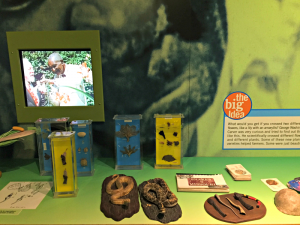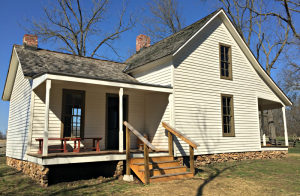Nature & History
When cabin fever runs rampant in my house here in Joplin, I become Doctor Mom and order one of the following prescriptions for my three restless daughters, who range in age from 5 to 13: Comb through exposed rocks from the creek bottom and find a treasured fossil or arrowhead.
Doctor Mom Knows Best: A Mother’s Prescription for Restless Kids

Wind your way up Bluff Trail and enjoy and a bird’s-eye view of sparkling Shoal Creek below.

Count the number of turtles you see sunbathing on tree limbs that have fallen into Williams Pond.

The first two prescriptions can be filled at Shoal Creek Conservation Education Center, and the final one at George Washington Carver National Monument. As Doctor Mom, I’ve chosen these two centers for restlessness rehab because they are close to home, they offer a variety of remedies for my not-so-patient patients, and they are stunningly beautiful.
Thanks to these resources, I’m proud to say Doctor Mom’s cure rate is 100%. What’s even more exciting is that it works on anyone, even people just visiting Joplin. In fact, visitors may enjoy their dose of nature therapy so much that they’ll feel compelled to return multiple times for follow-up appointments.

Shoal Creek Conservation Education Center
When the kids need to step away from the television and get some fresh air, I turn off the TV and say, “Let’s go to Shoal Creek and Wildcat Park!”
The girls cheerfully chat during the car ride over to Shoal Creek Conservation Education Center, located just south of Joplin. The center, which utilizes green technology, offers environmental education classes, children’s nature programming, and a discovery center.

Once inside, each girl becomes engrossed in her own thing: one follows the fluid movements of the native turtles and fish inside the impressive 1,300-gallon tank; another watches in fascination as a native rat snake uncoils its shiny body and begins exploring the perimeter of its terrarium; and the youngest stands in front of an interactive learning exhibit, gleefully pressing buttons as she learns more about the local environment.

Moments later, we prepare to hit the trails located around the center, in the area known as Wildcat Park. There are seven to choose from, and they cover more than three miles of diverse landscape—some of it rather unusual.
Once we exit the rear doors of the center, we immediately feel like we’ve been transported to Arizona. We see cacti growing along the trail and lizards scurrying across the arid ground. This desert-like ecosystem, filled with an unusual combination of plants and animals, represents some of the last remaining exposed chert glades in the world.

As we continue along the path, the scenery changes from the dry, sunny glades to the cool, wooded forest by Shoal Creek. My husband and I often hike the mile-long Bluff Trail, which offers stunning views of the creek, but today my daughters unanimously vote for taking St. John’s Creek Trail. Why? Because this half-mile path goes past a cave, and for three young girls, looking in to a cave is practically magical. Though the cave entrance is closed to the public, I still love watching their imaginations run wild together.

Imaginations have been sparked among my patients. Doctor Mom smiles, satisfied that the treatment plan is working.
George Washington Carver National Monument
For Doctor Mom, visiting the birthplace of the “Plant Doctor,” is like a pilgrimage; in addition to superior nature therapy, it offers rich historical, educational, and spiritual lessons, as well.
During the short drive south of Joplin to Diamond, my girls ask me questions like, “Who was George Washington Carver?” and, “How come he has a park named after him?”
George Washington Carver was born into slavery toward the end of the Civil War, most likely in 1864, one of many siblings. Soon after his birth, he, one of his sisters and his mother were kidnapped, and Moses Carver, who owned George and his mother, paid an agent to track them down. Of the three only the infant George was located and returned. Moses and Susan Carver then raised George and his brother, James, as their own. Being a sickly boy, he was excused from chores and allowed to wander the woods and prairie instead, during which time he learned about native plants and developed a talent for taking care of them, earning the name of the “Plant Doctor.”
Carver’s thirst for knowledge was unquenchable, and he spent his life exploring and educating, blazing the trail for other African Americans to follow.
To honor the important agricultural and educational contributions that Carver made to this country, the George Washington Carver National Monument was established in 1943. This 240-acre park is part of the National Park Service, which celebrates its 100th anniversary in 2016. It’s also the first national park to be named after a non-president, as well as the first one to be dedicated to an African American.
When we arrive at the park’s visitors center, my husband and I enjoy reading about Carver’s life in the museum exhibit, the kids look at slides of native plant and insect specimens under microscopes in the discovery area, and play teacher in the old-fashioned school room, instructing their students to write their names on the individual slate boards at their desks.



Then we go outside to walk the 3/4-mile nature trail. Near the beginning, we see a replica of the base of the 12′ x 12′ cabin where Carver was born. Doctor Mom gathers her patients inside of it and asks, “Can you imagine if we all lived together in such a small space? Talk about cabin fever!” Their eyes grow wide, and in them I see a new appreciation for their individual bedrooms in our modern house.
The trail, which is nicely paved, leads into the thick woods. As we pause to look at a bronze statue of Carver as a boy, a blue butterfly lands on it. Even the likeness of Carver seems to commune with nature.

We cross the pristine Carver Spring, then loop around Williams Pond, our voices startling turtles on the banks, causing them to dive in the water with loud plunks.

After walking through the 1881 Carver homestead, we finally emerge in the prairie restoration area.
I slow my pace, allowing my family to move ahead of me on the path. I watch as butterflies dance around their contented faces. I understand why Carver saw divine goodness in the natural world around him, rising early each day to take a devotional walk in the woods in order “to talk with God.”

The natural beauty of this area possesses great power; it can raise doleful spirits, entertain the minds of children, and bring smiles to faces.
Just like what Doctor Mom ordered.
Related Stories
Wildcat Park
Nearly every weekend, I get the urge to get outside and hike. Because I crave variety, I like to switch…
Details
The Top 5 Picnic Spots in Joplin
An ideal picnic spot is naturally shaded – in other words, not in a shelter or pavilion. If I’m going…
Details
Expanding Young Minds: Weekend Programs for Kids
Learning doesn’t have to stop at end of school week (although kids might want it to). Many places in the…
Details
Geocaching in Joplin
Geocaching is basically an outdoor scavenger hunt that combines adventure with technology. It involves searching for an object that is…
Details




